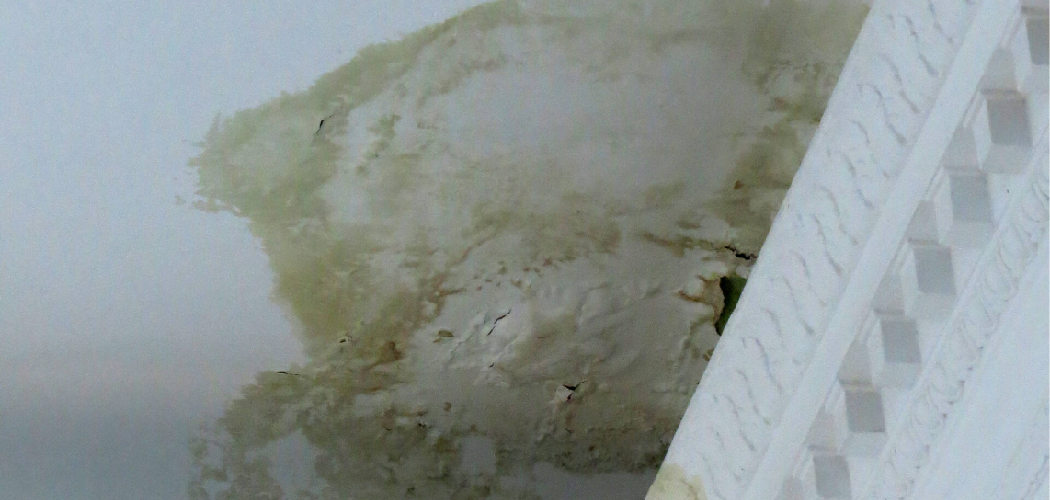Excess moisture on a ceiling not only creates an unattractive appearance but can also lead to severe damage, compromising the structural integrity of your home and fostering mold and mildew growth.
Knowing how to effectively remove moisture from a ceiling is a crucial skill for any homeowner. In this comprehensive guide, we’ll explore a range of methods and techniques on how to remove moisture from ceiling.
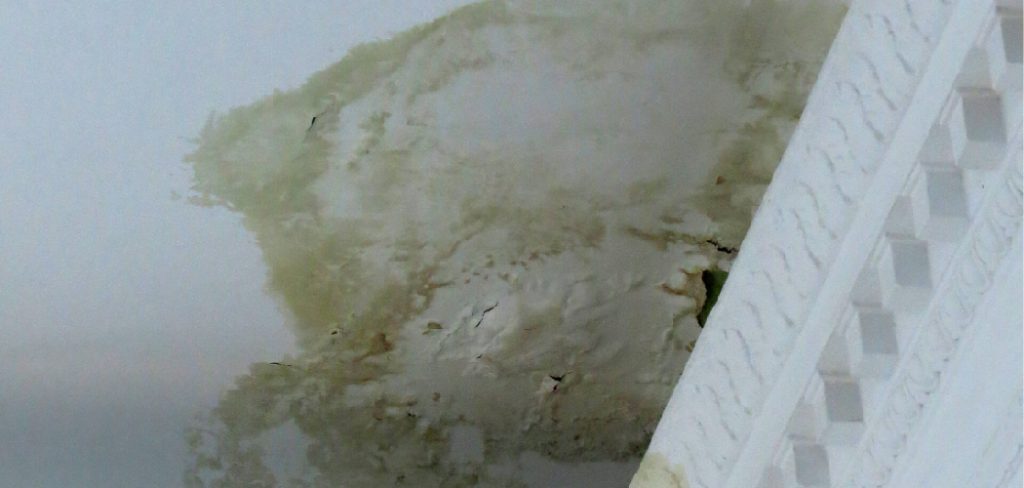
From identifying the sources of moisture to employing appropriate ventilation, dehumidifying, or insulation solutions, we’ll cover the necessary steps to eradicate excess moisture and prevent its return.
Protect your home and maintain a healthy indoor environment by learning how to address moisture issues effectively and safeguard the beauty and durability of your ceiling.
Importance of Addressing Moisture Problems Promptly
When it comes to home maintenance, one of the most important things to address is moisture problems. These issues can lead to costly repairs, health hazards, and damage to your property. In particular, removing moisture from your ceiling should be a top priority as this area is often overlooked and can cause serious problems if left unattended.
One of the main reasons why addressing moisture problems promptly is essential is due to the potential for mold growth. Moisture is a key factor in mold growth, and if left unchecked, it can quickly spread throughout your home. Mold not only causes unsightly stains on your ceiling but can also lead to respiratory issues and allergies. In severe cases, exposure to mold can even result in serious health problems.
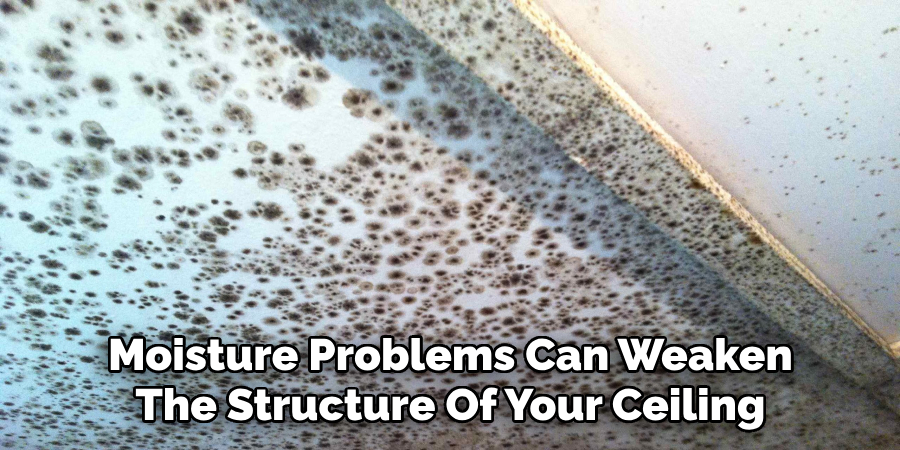
Moreover, moisture problems can weaken the structure of your ceiling. If left untreated, excess moisture can cause the ceiling to become weak and eventually collapse. This not only poses a danger to anyone in the vicinity but also requires costly repairs that could have been avoided if addressed promptly.
The Root Cause of the Moisture Issue
The presence of moisture in ceilings is a common household problem that can lead to serious structural damage if left unchecked. There are various reasons why moisture builds up on ceilings, but the most common culprit is poor ventilation.
When warm, moist air from inside the house comes into contact with a cold surface, such as the ceiling, it condenses and creates droplets of water. This can also happen in high-humidity environments, where the air is already saturated with moisture.
Besides poor ventilation, other factors that contribute to moisture buildup on ceilings include roof leaks, plumbing issues, and improper insulation. Regardless of the cause, it’s important to address the root cause of the issue rather than just treating the symptoms. However, identifying the root cause can sometimes be challenging, especially if there are multiple factors at play.
Roof leaks are a common cause of moisture on ceilings and should be addressed immediately to prevent further damage. If you notice water stains or discoloration on your ceiling, it’s important to inspect your roof for any signs of leaks. This could include missing shingles, damaged flashing, or clogged gutters. It’s also important to regularly maintain your roof to prevent future leaks.
10 Methods How to Remove Moisture from Ceiling
1. Use a Dehumidifier
Using a dehumidifier is one of the most effective ways to remove moisture from a ceiling. Dehumidifiers work by drawing in humid air and removing the moisture from it, which helps to reduce the humidity in the room. The collected water can then be emptied out or piped away through a drain line. Additionally, dehumidifiers can help to improve indoor air quality by reducing mold and mildew growth.
2. Increase Ventilation
Increasing ventilation is another easy way to remove moisture from a ceiling. Opening windows and doors can help to increase airflow and reduce humidity levels in the room. Additionally, using an exhaust fan or installing additional vents in the ceiling can also help to reduce moisture levels by drawing out humid air and replacing it with drier air from outside.
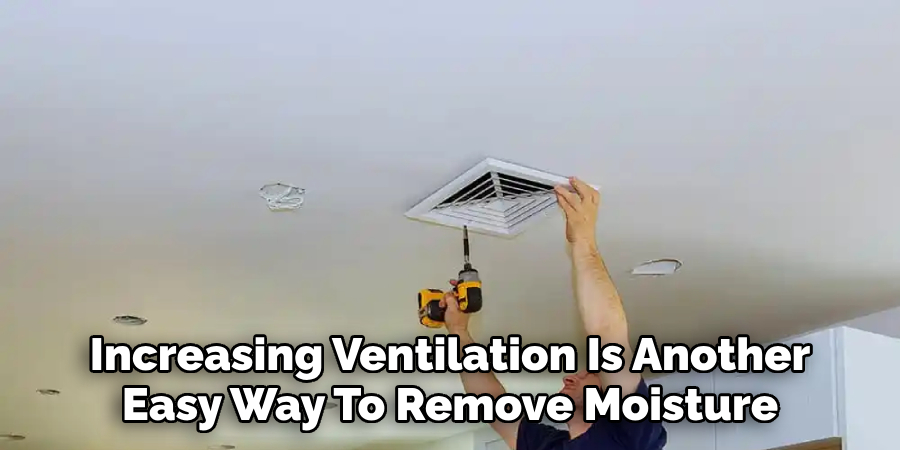
3. Use Fans
Using fans is another simple way to remove moisture from a ceiling. Setting up fans around the room can help to circulate air and reduce humidity levels in the area. Additionally, placing fans directly on wet spots on the ceiling can help to dry them out more quickly as well as prevent mold growth.
4. Use Absorbent Materials
Using absorbent materials such as towels or rags is another method for removing moisture from a ceiling. These materials are placed directly onto wet spots on the ceiling and left for several hours or overnight so that they can absorb any excess moisture present in the area. Afterward, they should be removed and replaced with fresh materials until all of the moisture has been removed from the area.
5. Apply Heat
Applying heat is another effective way to remove moisture from a ceiling. Using a space heater or other heating device can help to raise temperatures in the room, which will cause any trapped moisture in walls or ceilings to evaporate more quickly than normal due to increased evaporation rates at higher temperatures. However, care should be taken when using this method as excessive heat may damage paint or wallpaper on ceilings or walls if not monitored carefully.
6 . Seal Any Leaks
Sealing any leaks present in walls or ceilings is important for preventing future problems with dampness and mold growth caused by trapped moisture inside these areas of your home . This should be done before attempting other methods such as applying heat or using absorbent materials , as these will only provide temporary solutions if leaks are not sealed first . To seal leaks , use caulk , expanding foam , weather stripping , etc . depending on where they are located .
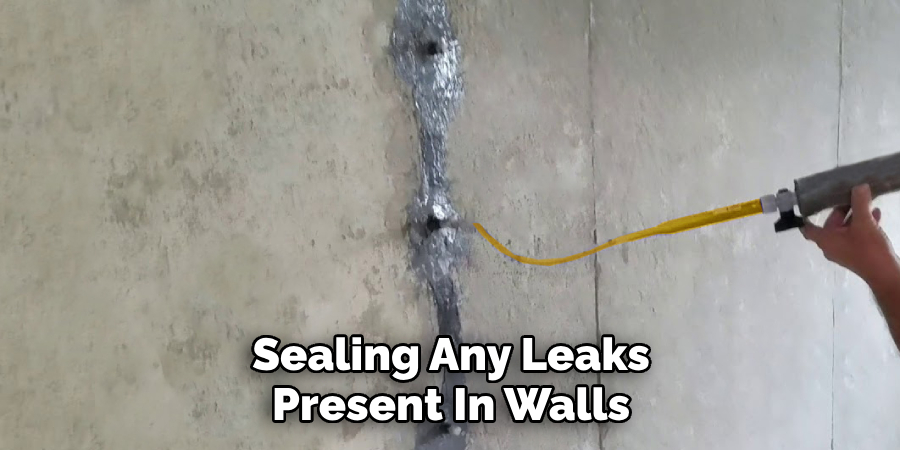
7 . Insulate Your Home
Proper insulation of your home is essential for keeping warm air inside during winter months and preventing cold drafts coming into your house during summer months . This helps keep interior temperatures more consistent throughout different seasons , which reduces condensation buildup on walls and ceilings due to temperature fluctuations . Additionally , properly insulating your home will also help save energy costs due to reduced heating/cooling needs .
8 . Clean Regularly
Regular cleaning of ceilings helps prevent dirt buildup which could lead to dampness issues over time if left unchecked . Cleaning should be done with soap and water (or mild detergent ) followed by drying off with soft cloths / towels afterwards so that no residue remains behind after cleaning has been completed .
Additionally , cleaning should also include removing cobwebs / dust regularly since these can trap humidity against surfaces leading eventually lead towards dampness issues if left unchecked for long enough periods of time .
9 . Use Paint With Mold-Resistant Properties
Applying paint with mold-resistant properties onto ceilings is another good way of preventing future dampness issues caused by trapped moisture within these areas of your home . There are many different types of paints available that have been specifically designed for this purpose – look for labels that say “mold-resistant” when shopping around for paints at local stores / hardware shops near you !
10 . Check For Plumbing Leaks
Lastly , checking for plumbing leaks within your house is important since water damage caused by leaking pipes could easily lead towards dampness issues if not fixed immediately upon discovery ! Make sure you inspect all visible piping around bathrooms / kitchens / basements etc … regularly (at least once every few months ) so that any potential plumbing problems can be identified early on before they become too serious !
Common Mistakes to Avoid When Removing Moisture from Ceiling
To help you avoid these errors, here are some of the most common mistakes people make when removing moisture from their ceilings:
- Not Addressing the Source of Moisture: One of the biggest mistakes people make is only focusing on removing the visible signs of moisture without addressing the root cause. This can lead to recurring problems and potential mold growth.
- Using Improper Techniques or Equipment: Removing moisture from ceiling requires specific techniques and equipment, such as dehumidifiers, fans, and moisture meters. Using incorrect methods or tools can be ineffective and may even cause more damage.
- Not Acting Quickly: Moisture can easily spread and cause damage to other areas of the home if not addressed promptly. It’s essential to act quickly when dealing with moisture on the ceiling to prevent further issues.
- Ignoring Safety Precautions: Removing moisture from ceilings often involves working at heights or handling potentially hazardous materials, such as mold. It’s crucial to take the necessary safety precautions to protect yourself and others.

Conclusion
Damp or moist ceilings can be an unsightly problem, but it is possible to rid of any moisture on your ceiling through a few simple steps. You can use a dehumidifier or fan to circulate air, replace insulation if necessary and apply silicone or oil-based sealant to the areas affected.
Taking the time to properly diagnose and solve the problem of dampness from your ceiling will save on more expensive repairs and will allow you to get many more years of enjoyment out of your home.
Lastly, never underestimate the importance of prevention; by maintaining proper ventilation in your home you can nip potentially hazardous problems like diseases due to mold growth in the bud. How to remove moisture from ceilings may seem daunting at first, but with the right tools and techniques, it really doesn’t have to be so intimidating.
